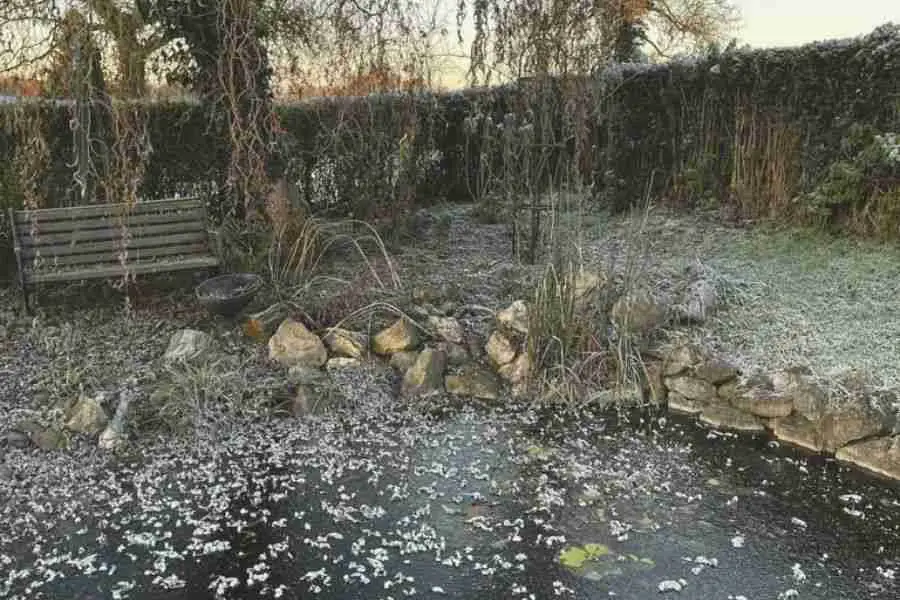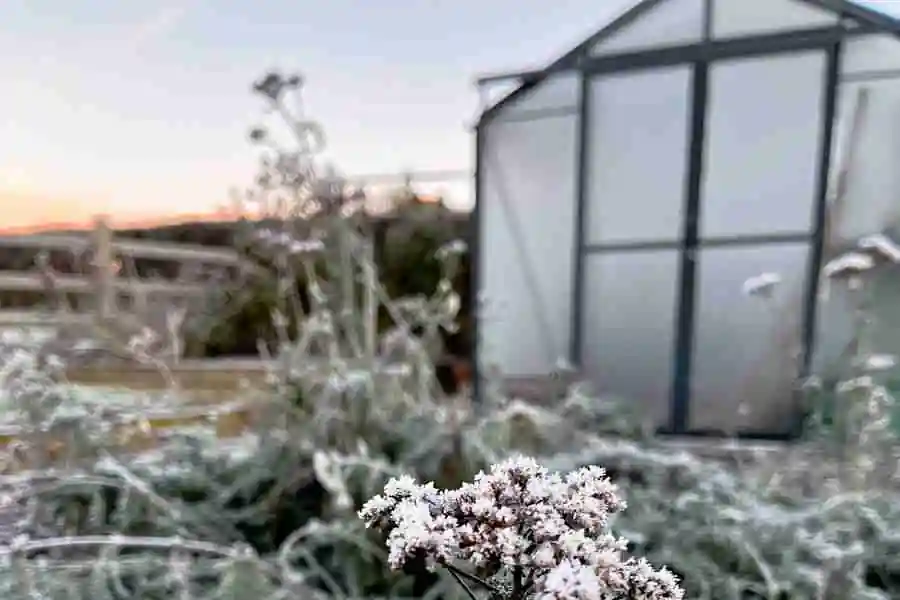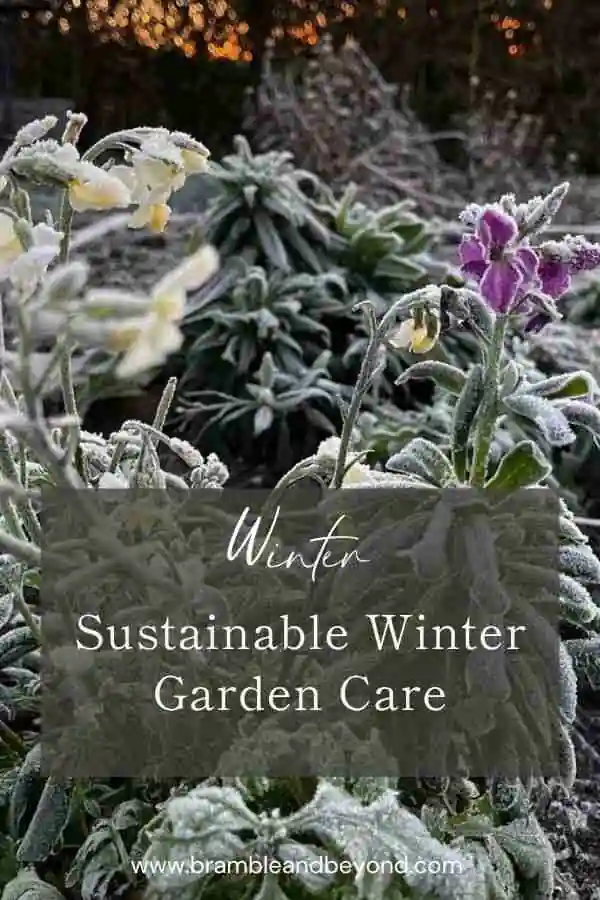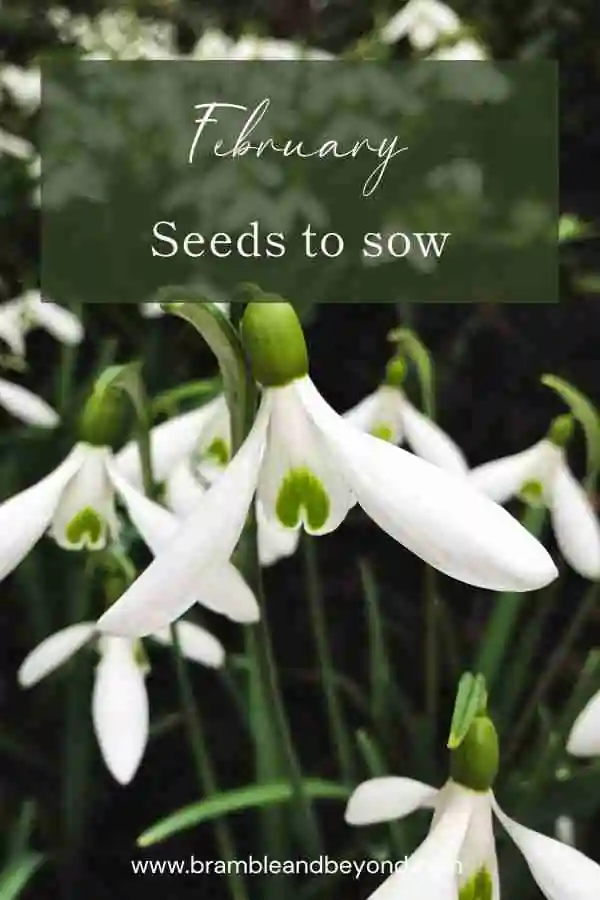Disclosure: This post may contain affiliate links, meaning I get commission if you decide to make a purchase through my links, at no cost to you. Please read my Affiliate Disclosure for more information.
As winter sets in, our gardens undergo a dramatic transformation. The lush greens and vibrant blooms of summer give way to a quieter, more subdued landscape. But don’t be fooled—your garden is still very much alive, and it needs your attention. Winter garden care is essential to ensure that your plants not only survive the cold months but also thrive once spring returns.
In a nutshell, effective sustainable winter garden care consists of mulching, composting, water conservation, protecting delicate plants and pruning strategically to boost growth.
In this post, we’ll explore eco-friendly practices that can keep your garden healthy throughout the winter, covering everything you need to know about sustainable winter garden care. Plus, we’ll dive into specific tips for protecting your beloved flowers during this chilly season.
So, grab your heated gardening gloves, and let’s dig in!
Understanding sustainable winter garden care
Sustainable garden care is all about working with nature rather than against it. It involves practices that promote the long-term health of your garden without depleting resources or harming the environment. In winter, this means using methods that protect your plants from the cold while maintaining the integrity of your soil and supporting local ecosystems.
Why is this important? Well, the winter months can be particularly harsh on gardens. Freezing temperatures, wet conditions and reduced sunlight can take a toll on your plants, especially if they’re not properly cared for.
Sustainable practices ensure that your garden not only survives the winter but also flourishes in the spring, with rich soil, healthy plants, and a balanced ecosystem.
General winter garden care
In general, winter is a great time for things to rot and decay, which in turn can cause pests and diseases, so having a clear up is important to your garden’s health. Winter isn’t really the time to do much work in the garden, I definitely take a slow gardening approach, but there are a few useful and small things you can do if a warmish and dry presents itself. Here are just a few jobs I try and accomplish revolving around keeping your garden tidy:
- Bird bath maintenance: Ensure bird baths are filled with fresh water daily, especially in frosty weather.
- Watering equipment storage: Store watering equipment like hoses and sprinklers indoors to prevent them from freezing and splitting.
- Pond debris removal: Remove fallen leaves and debris from ponds, allowing pond life to escape before adding them to the compost bin.
- Shed tidying: Tidy up your shed by organising and cleaning your tools.

By following these guidelines, and nipping out into the fresh air when you can, you will be helping your garden care for itself, whilst you care for yourself.
Greenhouse winter garden care
My main aim in the winter is to stay as warm and dry as possible, so my greenhouse becomes my sanctuary. Here are some of the things I potter about doing:
- Remove dead leaves and flowers: Regularly remove faded leaves and dead flowers from overwintering greenhouse plants, such as pelargoniums.
- Get bushier sweet peas: Encourage bushier growth in autumn-sown sweet peas by pinching out their tips.
- Provide extra protection: Some of your autumn-sown hardy annuals may require a bit of extra protection if it gets really cold. Move them away from the glass and place some insulating material (bubble wrap or just cloth) between them and the glass.
- Greenhouse temperature monitoring: Use a max-min thermometer to monitor greenhouse temperatures efficiently. For cost-effective heating, check out my free greenhouse heating ideas.
- Watering sparingly: Water plants sparingly to maintain a dry greenhouse environment and reduce disease risk.
- Pest inspection: Inspect overwintering plants in the greenhouse for pests like red spider mites, mildew and damping off and treat if necessary.
- Seed sowing: Get an early start on your spring seed sowings and start some hardy annuals.
Taking care of your plants in the greenhouse is a vital task to maintain throughout winter. I’ve lost many a plant by taking my eye off the ball.

The role of flowers in winter gardens
Flowers might not be the first thing that comes to mind when you think of a winter garden, but they play a crucial role in maintaining the beauty and enjoyment of your outdoor space. Certain winter-blooming flowers, such as Hellebores, Winter Jasmine, and Snowdrops, can add a splash of colour to your garden even in the coldest months. But beyond their aesthetic value, these flowers are vital for supporting local wildlife, such as bees and birds, which rely on them for food and shelter.
Winter garden care for outdoor flowers involves more than just planting hardy species. It’s about creating an environment where they can thrive despite the challenges of winter. This includes protecting them from frost, ensuring they have adequate nutrients, and using sustainable practices that promote their health and growth.
Organic mulching for winter garden care
Mulching is one of the most effective ways to protect your garden during the winter. It acts as a blanket for your soil, helping to regulate temperature, retain moisture, and prevent erosion. In winter, when the ground can freeze and thaw repeatedly, mulching is particularly important. It helps to insulate plant roots, reducing the risk of frost damage.
This is especially important if you have heavy clay soil, like me. Most plants don’t enjoy sitting in cold damp soil, and clay soil hangs onto all of that rain water. If you then get a frosty night it can do irreparable damage to your precious plants.
Improving soil structure for optimal water flow is your main goal in the garden, both for winter damage control and enhanced fertility during the growing season. Mulching is one of the best methods to achieve this with minimal effort.
How to apply mulch sustainably
When it comes to mulching, not all materials are created equal. For winter garden care of the soil, it’s best to use mulches such as leaves or home made garden compost. These materials are not only eco-friendly but also effective at insulating your soil and protecting your plants. They also will break down quickly which enriches your soil, providing essential nutrients for your plants.
I have found that using straw and wood chip overwinter causes me problems in our damp British weather. Whilst excellent at weed control and moisture retention. That same ability to retain water and keep the ground warm, creates a perfect breeding ground for pests, such as slugs and snails, so I no longer use it on my garden, although I do add it to the compost heap.
Before applying mulch, make sure your garden is clean and free of debris. Remove any soggy decaying leaves on perennials or annuals. Things that have a lot of foliage that seems to create a bed of soggy mush, I’m thinking of you Crocosmia!. These plants have very slow to decompose leaves and just stay damp all winter. This makes them ideal shelter for pests and not useful for other sheltering birds or animals.

You don’t have to clear everything, as some debris is perfect for sheltering animals or a food source if there is seed heads.
Spread the mulch evenly over your garden beds, aiming for a thickness of about 5 cm/ 2 inches. Be careful not to pile it up against the stems of your plants, as this can cause rot.
By doing this you’ll create a protective barrier that helps your plants survive the winter while also enriching your soil for the spring growing season.
Winter composting
Composting might seem like a warm-weather activity, but it’s actually a crucial part of winter garden care. Composting during the winter helps keep you on top of the compost creation ready for the spring. The result helps to maintain the health of your soil and provides a steady supply of nutrients for your plants. Plus, it’s a sustainable way to recycle organic waste from your garden and kitchen.
In winter, composting can be a bit trickier due to the cold temperatures, but with the right approach, you can keep your compost pile active all season long. The key is to maintain a balance between green (nitrogen-rich) and brown (carbon-rich) materials and to keep your pile as warm and moist as possible.
How to maintain a compost pile in winter
Keeping your compost pile active in winter requires a bit of extra care, but it’s well worth the effort. Here’s how to do it:
- Position your compost pile: Place your compost pile in a sheltered spot that receives sunlight during the day. This will help keep it warm. You will likely produce less garden waste over the winter so it may be prudent to make a smaller heap than your summer heap. This way you can create a control the heat better.
- Layering is key: Alternate layers of green materials (such as vegetable scraps and grass clippings) with brown materials (such as leaves and straw). This helps to maintain the right balance of nutrients.
- Moisture management: Keep your compost pile moist, but not too wet. In winter, it’s especially important to monitor moisture levels, as the cold can cause your pile to dry out. If necessary, add water to keep it damp.
- Insulate your pile: Consider covering your compost pile with a tarp or a layer of straw or even some old carpet to help retain heat. This will keep the composting process going even in cold weather.
- Turn the pile regularly: Turning your compost pile helps to aerate it and speeds up the decomposition process. How often you turn it is up to you but the more often the quicker the compost is produced.
Winter composting might take a bit more effort, but it pays off in the long run. Come spring, you’ll have rich, nutrient-dense compost to feed your garden and promote healthy plant growth.
The above is the ‘ideal’ way of doing it, but if you are anything like me I don’t do much gardening in winter once the ground is all prepped. And in reality, finding green materials is difficult. Much like its difficult to find brown materials in the summer. I tend to have a compost pile going which I add my kitchen scraps to, but I leave the brown materials from the garden in a pile to the side. This new pile is used as my brown material stash for use in the summer months. This means I can cycle through heaps quicker in the warmer months and make more compost then rather than making my life difficult in the winter. There, I’ve said it, I’m a lazy gardener wherever possible.

Special care tips for winter flowers
Winter flowers, like Hellebores, Winter Jasmine, and Snowdrops, bring much-needed colour to your garden during the cold months and can usually withstand the harshest of weather. They also provide a bit of food and shelter for any passing insect that might sneak out.
However, other hardy plants can still be vulnerable to the harsh conditions of winter. To keep them thriving, it’s important to take extra precautions:
- Move potted plants: If you have flowers in pots, move them to a sheltered spot when the temperature drops. The roots of potted plants are more exposed to the cold, so providing them with extra protection is crucial.
- Bring hyacinths indoors: Transfer hyacinths from the greenhouse into your home, ensuring they are placed in a cool, bright spot to encourage blooming.
- Wrap terracotta pots: Terracotta pots can crack in freezing weather, so either bring them indoors or wrap them in bubble polythene for insulation.
- Fertilise and water sparingly: Winter flowers don’t need as much fertiliser and water as summer blooms. Use compost or a slow-release fertiliser to provide them with the nutrients they need without overfeeding or overwatering.
- Use protective covers: If severe frost is forecast, cover your winter flowers with cloches or fleece to protect them from the cold. This is especially important for tender varieties that are more susceptible to frost damage.
- Feed the wildlife: Hang bird feeders near roses to attract hungry birds that will also pick off any overwintering pests.
- Check for damage: Check stored bulbs and corms regularly for any signs of rot.
By incorporating these sustainable practices into your winter garden care routine, you not only ensure the health and beauty of your garden through the colder months but also contribute to better growth in the future.
Encouraging winter blooms sustainably
To keep your flowers blooming beautifully, it’s important to take a sustainable approach to their care. Here are some tips:
- Prune carefully: Prune climbing roses and other flowering plants between now and February. This encourages healthy growth and helps them bloom beautifully in the spring.
- Plant bare-root roses and deciduous shrubs: This is the perfect time for planting bare-root roses and other deciduous shrubs, allowing them to establish roots before spring.
- Hard prune overgrown shrubs and hedges: Take advantage of the dormant season to hard prune any overgrown shrubs and hedges, promoting healthy growth when the warmer months return.
- Plant fragrant shrubs: Consider planting fragrant winter shrubs like Chimonanthus, Sarcococca, and Daphne odora in pots on your doorstep. Not only do they look and smell lovely, but they’re also hardy enough to thrive in winter conditions.
- Cut stems for decorations: Winter-flowering shrubs like holly and ivy are perfect for making festive decorations and wreaths.
- Plan for next year: Winter is the perfect time to start planning for next year’s garden. Order seeds and summer-flowering bulbs like dahlias, lilies, and gladioli, and start thinking about where you’ll plant them.
By following these tips, you can keep your winter flowers looking their best all season long, while also supporting sustainable gardening practices.
Winter garden care might seem like a daunting task, but with the right approach, it can be both manageable and rewarding. By focusing on sustainable practices like mulching, composting, and having a good tidy up, you can keep your garden healthy and thriving through the cold months. And by taking special care of your winter flowers, you can ensure that your garden remains a beautiful and vibrant space, even in the depths of winter.
Embrace the serenity of winter gardening and take pride in knowing that your efforts will yield a flourishing landscape come spring.
So, bundle up, head out into your garden, and enjoy the simple pleasures of winter gardening. Your plants—and your soul—will thank you.







